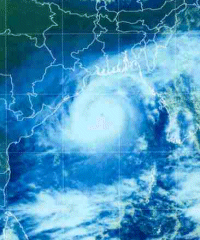
Cyclone Warnings ( Back to Cyclone Warning Services ) Cyclone warnings are disseminated through a variety of communication media, such as, radio, television, print media, telephones, fax, telex, telegrams, police wireless network. A specially designed Cyclone Warning Dissemination System which works via the INSAT satellite provides area-specific service even when there is a failure of conventional communication channels. Warnings are issued for general public, fishermen, farmers and different categories of users such as central and state government officials responsible for disaster mitigation and relief, industrial and other establishments located in the coastal areas, railways, aviation, communications and power authorities.
The cyclone warnings are issued two stages.The first stage warning known as "Cyclone Alert" is issued 48 hours in advance of the expected commencement of adverse weather over the coastal areas. The second stage warning known as "Cyclone Warning" is issued 24 hours in advance. A ?Pre-cyclone Watch? may be instituted prior to the cyclone alert and a post-landfall outlook is issued for areas in the interior which may be affected by the cyclone as it continues to move inland and dissipate. Regional Specialised Meteorological Centre
NHAC, New Delhi, has been designated as the Regional Specialised Meteorological Centre for Tropical Cyclones. It is one of the five such centres recognised by the WMO under a global system for monitoring tropical cyclones. As an international commitment, through the WMO/ESCAP Panel on Tropical Cyclones, tropical cyclone advisories are issued by RSMC, New Delhi to the panel member countries during the tropical cyclones in the Bay of Bengal and the Arabian Sea.
The advisory messages are issue four to eight times a day. The ESCAP Panel countries are Thailand, Myanmar, Bangladesh, Pakistan, Sri Lanka, Maldives and Oman.